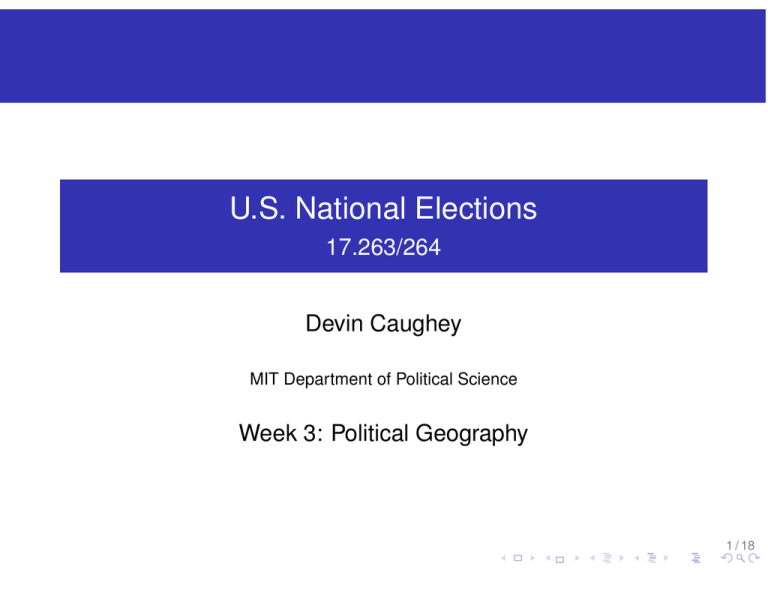
U.S. National Elections
17.263/264
Devin Caughey
MIT Department of Political Science
Week 3: Political Geography
1 / 18
Themes of the day
1
Geography matters.
Distribution of voters across space
Influence of geographic context
2
Geography misleads.
Ecological fallacy
Different patterns in different places
2 / 18
Tobler’s First Law of Geography
“Everything is related to everything else, but near things are
more related than distant things.”—W. F. Tobler
Segregation: similar people forced to live together (e.g.,
black ghettos)
Homophily: people choose to live near others like
themselves (e.g., hipsters in Williamsburg)
Socialization: people become more similar to those around
them (e.g., Southerner moves north and loses drawl)
3 / 18
Political Implications of Tobler’s Law
Different kinds of people (voters) are not distributed evenly
across space.
Different areas have different political leanings.
Especially consequential in systems with single-member
plurality districts
4 / 18
Liberals Cluster in Cities
Across industrial societies. . .
Industrial working class concentrated in urban areas
! economic liberalism (socialism)
Highly educated professionals attracted to urban culture
! social liberalism (secular cosmopolitanism)
=) Liberals (US Democrats) are highly concentrated in cities.
Also true of conservative-leaning groups (wealthy white
suburbs, Mormon Utah), but less extreme.
5 / 18
Electoral Bias: Democrats Are Inefficiently Distributed
2000 Election
40
Bush % of two−party vote: 49.7%
Districts carried by Bush: 52.4%
Number of Districts
30
20
10
left skew
207 Gore districts
228 Bush districts
0
−100 −90 −80 −70 −60 −50 −40 −30 −20 −10
0
10
20
30
40
50
60
70
District Margin for Bush Relative to Nation (%)
6 / 18
Erikson: Sources of Partisan Bias
Pre-1964: pro-Republican bias
Natural gerrymander: Republican ++
Unequal district population: rural + (no party advantage)
1964–1994: countervailing biases
Natural gerrymander: Republican ++
Incumbency advantage: Democratic +
Low turnout in Democratic districts: Democratic +
1994–2002: pro-Republican
Natural gerrymander: Republican ++
Incumbency advantage: Republican +
Low turnout in Democratic districts: Democratic +
7 / 18
Let’s think more about variation across the United States.
8 / 18
Church Attendance
Image by MIT OpenCourseWare
9 / 18
Income
Image by MIT OpenCourseWare
10 / 18
County Income and Republicanism, North vs. South
Courtesy of the American Economic Association. Used with permission.
11 / 18
The Ecological Fallacy
Geography matters, but it also misleads.
The “ecological fallacy”: inferring relationships
(correlations) among individuals from relationships among
geographic units.
Patterns or behaviors may also vary by context.
! Southern “black belt” (racial threat)
12 / 18
The Ecological Fallacy: Immigration and Income
% Immigrant ⇥ % Wealthy, by State
Correlation across
states: +0.52
Correlation across
people: 0.05
How can this be?
© Elsevier, Inc. All rights reserved. This content is excluded from our Creative
Commons license. For more information, see http://ocw.mit.edu/help/faq-fair-use/.
13 / 18
The Ecological Fallacy: Red State, Blue State. . .
What ecological fallacy do Gelman et al. dispute?
14 / 18
Income and Republicanism: Individuals vs. States
Richer people vote more
Republican (hollow dots)
Richer states vote more
Democratic (solid dots)—culture
Income variation is much greater
within states than across, so
national relationship is positive.
What about context?
Originally published in Gelman, Andrew, Boris Shor, et al. "Rich State, Poor State,
Red State, Blue State: What's the Matter with Connecticut?" Quarterly Journal of
Political Science 2, no. 4 (2008): 345-67. Used with permission.
15 / 18
Income and Republicanism: State Context Matters
Income matters more in rich
states than poor states.
It is the rich whose voting differs
across states, not the poor,
probably because the
cultural/religious attitudes of the
rich vary more (homophily?)
Originally published in Gelman, Andrew, Boris Shor, et al. "Rich State, Poor State,
Red State, Blue State: What's the Matter with Connecticut?" Quarterly Journal of
Political Science 2, no. 4 (2008): 345-67. Used with permission.
16 / 18
Causal Effect of Income?
Is the relationship between income and Republicanism a
causal one?
What else might be causing (“confounding”) the
relationship?
How do Gelman et al. address the problem of
confounding?
Suppose it were not causal. Why might we still care?
17 / 18
Image courtesy of Andy Arthur at http://andyarthur.org/map-median-household-income-in-ny-state-middle-class-biased-coloring-2.html License CC BY 3.0
18 / 18
MIT OpenCourseWare
http://ocw.mit.edu
17.263 / 17.264 U.S. National Elections
Fall 2014
For information about citing these materials or our Terms of Use, visit: http://ocw.mit.edu/terms.

